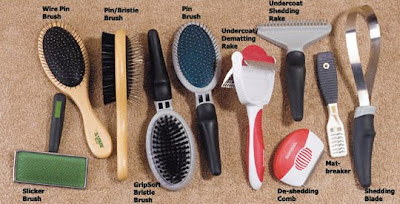Specific grooming brushes are designed for specific coats. There are a ton to choose from and we want to help you pick the one that is perfect for your pup.
Brushes
1.) Bristle Brushes can be used on all coat types and vary according to the spacing between bristles and the length of the bristles. The longer the coat, the more widely spaced and longer the bristles should be. The coarser the hair, the stiffer those bristles need to be.
2.) Wire-pin brushes (with or without rubber-tipped ends) are best for pets with medium to long hair as well as those with curly or woolly coats.
3.) Slicker brushes have fine wire bristles and are especially useful for removing mats and tangles. They are used mostly on dogs with dense undercoat, and not on smooth coated breeds.
Combs
1.) Fine tooth combs work best for soft and silky coats.
2.) Medium tooth combs are all-purpose.
3.) Wide tooth combs are ideal for heavy coats, and sometimes de-matting tasks.
4.) Rubber curry combs are effective at massaging the skin and removing dead hair from short-haired breeds, they also can be used to lather shampoo.
De-Matting Tools
1.) Mat splitters break the mat up into smaller pieces which are then more easily removed with brush and comb action. Be sure to obtain instruction in the proper use of this tool for the safety of pets.
2.) Grooming Rakes or Mattbreakers are great for removing any mats.
Type of Hair Coat | Recommended Brush Type | Brushing Direction |
Short, smooth coats (most Retrievers, Hounds, Chihuahuas, etc.) | Soft to medium bristle brush with short, closely spaced bristles | With the coat's grain |
Short, wiry coats (Terriers, etc.) | Firm bristle brush with short, closely spaced bristles; and a slicker brush | With the coat's grain |
Medium to long flowing coats (Golden Retrievers, Spaniels, Setters, Lhasa Apso, etc.) | Soft to medium bristle brush with long, medium- to wide-spaced bristles; a wire-pin brush; and a slicker brush for mats and tangles | With the coat's grain |
Harsh, outer coats with soft, woolly undercoats (Sheepdogs, Collies, Shepherds, Chows, Pomeranians, etc.) | Firm bristle brush with long, wide-spaced bristles; a wire-pin brush; and a slicker brush for tangles and mats | With the grain -- outer coat; Against the grain--under coat |
Thin, delicate coats (Yorkies, Maltese, etc.) | Wire-pin brush; and a soft slicker brush for tangles and mats | With and against the coat's grain |
Table Information excerpted from Guide to Home Pet Grooming by Dr. Chris C. Pinney, D.V.M.
TIP: Desensitize your pet to the grooming process. How? With snackage! Have loads of tasty treats and tidbits around when it comes time to conquer that coat. If you always offer rewards while brushing (combing, washing, clipping, etc.), your pooch will learn to look forward to this procedure.
A great trick I learned was to stick my pup in the bath tub and smear a little peanut butter on the tile in front of his nose. He would lick it off while I washed him, and it is super easy clean up!
Start slow, start young and be patient. It should feel good to be brushed and have the skin massaged; if you tug and pull too much through mats and snarls, your dog might not be such a fan of the procedure next time.
And Remember, in order to prevent problem mats and tangles from developing, be sure to brush your pet often!


The dog grooming brush brush from Essential Loved makes grooming so easy — it removes loose fur gently and keeps my dog’s coat smooth and shiny. Perfect for daily use!
ReplyDelete